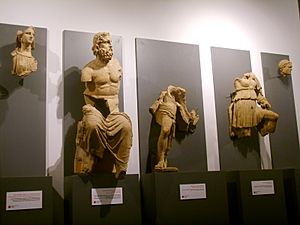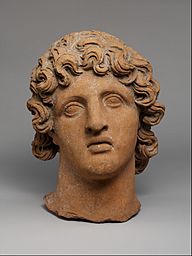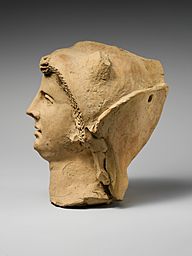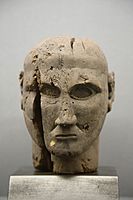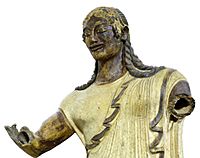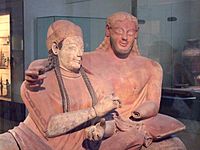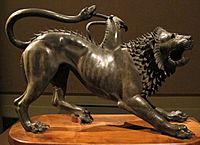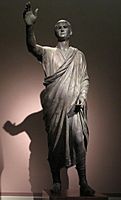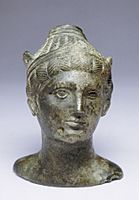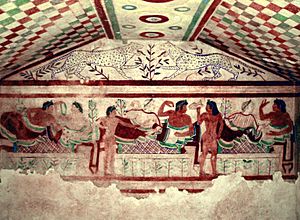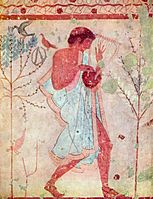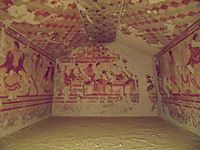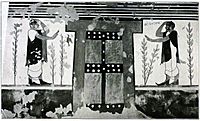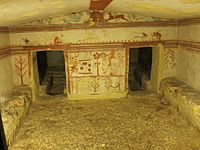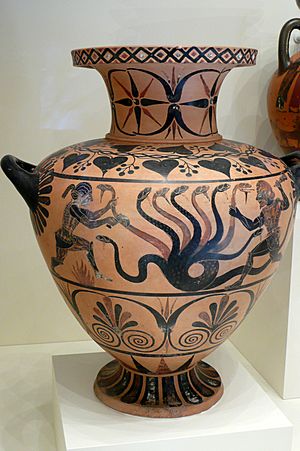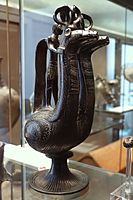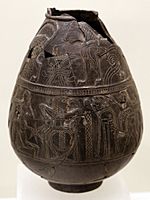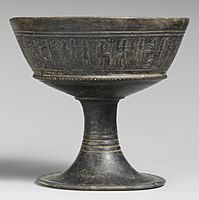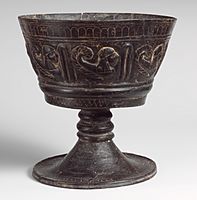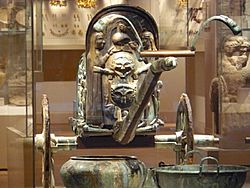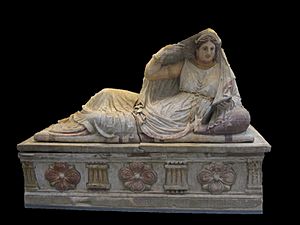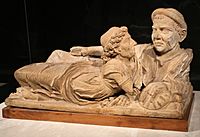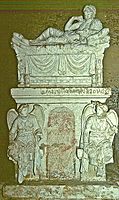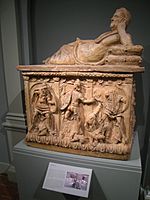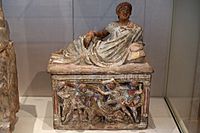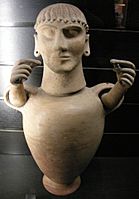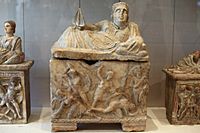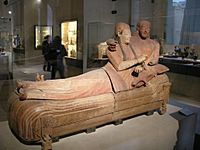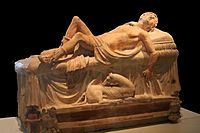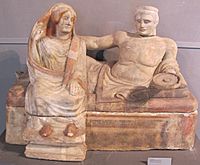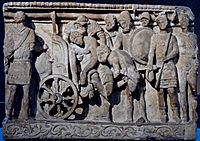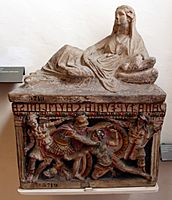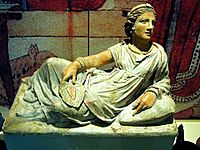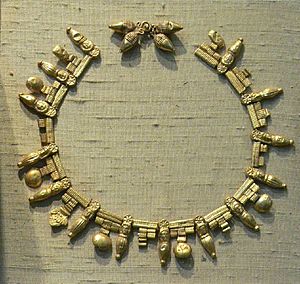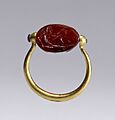Etruscan art facts for kids
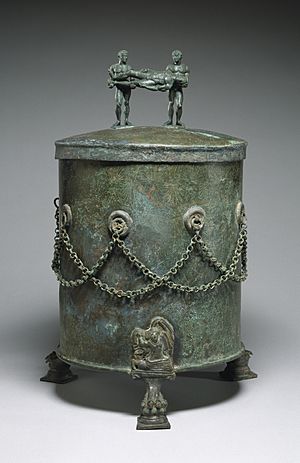
Etruscan art was created by the Etruscan civilization in central Italy. This art was made between 1000 BC and 100 BC. From about 750 BC, it was greatly shaped by Greek art. The Etruscans brought Greek art into their land. But their art always kept its own special style.
Etruscan artists were very good at making statues from terracotta (a type of clay). They made life-size figures for sarcophagi (stone coffins) and temples. They also excelled at wall-painting and metalworking, especially with bronze. Beautiful jewelry and engraved gems were also common.
Etruscan bronze sculptures were famous and sold widely. But not many large ones are left today. Bronze was very valuable, so it was often melted down and reused later. Unlike the Greeks and Romans, Etruscans made very few sculptures from stone. This is surprising because they had good sources of marble, like Carrara marble.
Most of the Etruscan art we have today comes from tombs. These tombs were often filled with sarcophagi and grave goods (items buried with the dead). Many terracotta pieces from temple decorations also survived. All the fresco wall-paintings we have come from tombs. These paintings show scenes of parties and stories from myths.
Bucchero pottery was an early and unique Etruscan style. It was black and shiny. There was also a tradition of detailed Etruscan vase painting. This style came from Greek vase painting. The Etruscans were the main buyers of Greek vases. Etruscan temples were brightly decorated with painted terracotta pieces called antefixes. These pieces are often found where the wooden parts of the temples have disappeared. Etruscan art was closely linked to their religion. The afterlife was very important in their art.
Contents
History of Etruscan Art
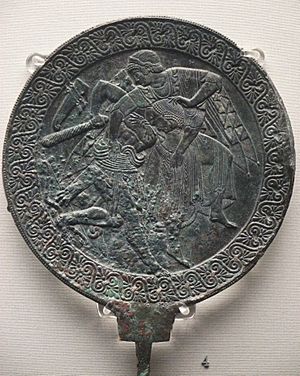
The Etruscans developed from the Villanovan culture. Other old cultures influenced Etruscan art. This happened during the Orientalizing period. Cultures like Greece, Phoenicia, Egypt, Assyria, and the Middle East traded with Etruria. The Romans later took over the Etruscan culture. But the Etruscans and their art also had a big impact on the Romans.
Art Periods of the Etruscans
Etruscan art is usually divided into different time periods:
- 900 to 700 BC – The Villanovan Period. Art from this time clearly shows a focus on funerary art (art for the dead). They made Impasto pottery with geometric patterns. Some pots were shaped like small huts. Bronze items were mostly small, except for vessels. They were decorated with patterns or carved lines. Small statues were often parts of vessels.
- 700–575 BC – The Orientalizing Period. Trade with other Mediterranean civilizations grew. These civilizations wanted metal ores from Etruria. This led to imports of foreign art, especially from Ancient Greece. Some Greek artists even moved to Etruria. Art decorations started using Greek and Near Eastern styles. These included patterns like palmettes. Lions were also popular animals to show. Rich Etruscans began to fill their large tombs with valuable items. A local black pottery, called Bucchero, became popular. It was now made using a potter's wheel. Painted vases, influenced by Greek art, also started appearing. Until 600 BC, these vases were more like those from Corinth than Athens.
- 575–480 BC – The Archaic Period. The Etruscans continued to get richer. Greek influence became even stronger. This happened even though the two cultures sometimes fought. During this time, the Etruscan temple appeared. It had colorful terracotta decorations. Other large buildings were also built. Art showing people and stories became more common. The Etruscans loved stories from Greek mythology. Paintings called frescoes started appearing in tombs. (Greeks had stopped making tomb frescoes centuries before). These paintings might have also been in other buildings. When Persia took over Ionia in 546 BC, many Greek artists moved to Southern Etruria. This period created some of the most beautiful and unique Etruscan art.
- 480–300 BC – The Classical Period. The Etruscans reached their peak in wealth and power. But the amount of art made decreased in the 5th century BC. Wealth moved from cities near the coast to inland areas. In the 4th century BC, art production increased again. Old styles continued to develop without big changes. However, red-figure vase painting arrived. More sculptures, like sarcophagi, were made from stone instead of terracotta. Bronze items from Vulci were sold widely. The Romans began to conquer Etruscan cities one by one. Veii was conquered around 396 BC.
- 300–50 BC – The Hellenistic Period. During this time, the remaining Etruscan cities slowly became part of Roman culture. Around 100 BC, it became hard to tell if art was Etruscan or Roman. Unique Etruscan items slowly stopped being made. The last painted vases appeared early in this period. Large painted tombs stopped being made in the 2nd century BC. Art styles continued to follow Greek trends. They became more detailed and realistic. Bronze statues, which were now larger, sometimes copied Greek designs. Large Greek temple sculptures for the triangular part of the roof (pediments) were introduced, but made from terracotta.
Etruscan Sculpture
The Etruscans were very skilled sculptors. Many examples still exist, made from terracotta, bronze, and alabaster. However, very few sculptures were made from stone. This is different from the Greeks and Romans. Terracotta sculptures from temples often need to be put back together from many pieces. But sculptures from tombs, like the special sarcophagus tops with life-size figures lying down, are usually in good shape. Their paint, however, has often faded. Small bronze pieces, often with sculpted decorations, became a big industry later on. These were sold to the Romans and others.
The famous bronze "Capitoline Wolf" in the Capitoline Museum in Rome was thought to be Etruscan for a long time. But its age is now debated. It might actually be from the 12th century AD.
Some famous Etruscan sculptures include:
- The Etruscan Head, 600 BC, at the Archaeological Museum in Milan.
- The Centaur of Vulci, 590–580 BC, at the National Etruscan Museum at Villa Giulia in Rome.
- The painted terracotta Apollo of Veii, 510–500 BC. This came from the temple at Portanaccio. It is thought to be by an artist named Vulca. It's at the National Etruscan Museum in Rome.
- The painted terracotta Sarcophagus of the Spouses, late 6th century BC. This came from Cerveteri and is at the National Etruscan Museum. There is a similar one in the Louvre museum.
- The bronze Chimera of Arezzo, from 400 BC. It's at the National Archaeological Museum in Florence.
- The Mars of Todi, a bronze sculpture from 400 BC. It's in the Museo Etrusco Gregoriano of the Vatican.
- The Sarcophagus of Seianti Hanunia Tlesnasa, 150–140 BC. This is a masterpiece of Etruscan art in terracotta. It's now at the British Museum.
- The Orator, or Aule Metele ("L'Arringatore" in Italian). This bronze statue was found in Umbria. It's now at the National Archaeological Museum in Florence.
The Apollo of Veii shows how skilled Etruscan artists were. It was made to decorate the roof of the temple at Portanaccio. While its style reminds us of the Greek Kroisos Kouros, putting statues on the roof was an original Etruscan idea.
Etruscan Wall-Painting
Most Etruscan paintings that still exist are wall frescoes from tombs. These are mainly found in Tarquinia. They date from about 670 BC to 200 BC. The best period for these paintings was between 520 and 440 BC. The Greeks rarely painted their tombs during this time. The Etruscan tradition is important because most Greek wall paintings are lost.
Etruscan tombs held the remains of whole families. These tombs were likely used for family ceremonies. The paintings probably had a religious meaning. A few painted terracotta panels have been found in tombs. These panels are about a meter tall. Fragments have also been found in city centers.
Fresco paintings are made by putting paint on wet plaster. When the plaster dries, the painting becomes part of the wall. Colors came from ground-up minerals. Fine brushes were made from animal hair.
From the mid-4th century BC, artists started using chiaroscuro. This technique shows depth and volume. Sometimes, scenes of daily life are shown. But more often, they show traditional stories from Greek mythology. The Etruscans seemed to have adopted many Greek myths. Party scenes are common. Sports and hunting scenes are also found. The way humans are drawn never reached the Greek level of detail. Proportions often look off in these paintings. Animals or people are sometimes shown out of proportion. Different patterns cover much of the space between the main scenes.
-
A Fresco of an Etruscan musician playing a barbiton. From the Tomb of the Triclinium, Tarquinia.
Etruscan Vase Painting
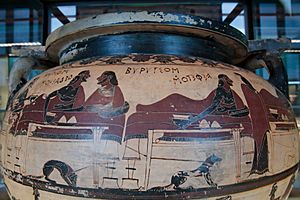
Etruscan vase painting was made from the 7th to the 4th centuries BC. It is a very important part of Etruscan art. It was heavily influenced by Greek vase painting. Etruscan artists followed the main Greek styles, especially those from Athens. However, they were usually a few decades behind. The Etruscans used the same methods and mostly the same vase shapes. Both the black-figure vase painting and the later red-figure vase painting techniques were used. The pictures on the vases often came from Greek mythology in later periods.
Besides making their own vases, the Etruscans were the biggest buyers of Greek pottery outside Greece. Some Greek painters probably moved to Etruria. There, richly decorated vases were a common item in tombs. It is thought that many or most of these fancy painted vases were bought specifically for burials. They were a cheaper and safer choice than silver or bronze vessels. The rich would have used these metal vessels in their daily lives.
Bucchero Ware
A truly unique Etruscan pottery style is called bucchero. These pieces are black, shiny, and not glazed. They were made black in a special oven that had no oxygen. This style grew from the pottery methods of the Villanovan period. Bucchero items were often decorated with white lines. This style might have become a traditional "heritage" look. It was kept in use especially for items placed in tombs.
-
Bucchero olpe, around 630 BC
Terracotta Panels
A few large terracotta panels or plaques have been found in tombs. These are much bigger than typical Greek art. Some form a series that acts like a portable wall painting. The "Boccanera" tomb at the Banditaccia necropolis in Cerveteri had five panels. They were almost a meter high and placed around the wall. These are now in the British Museum. Three panels form one scene, likely the Judgement of Paris. The other two were on either side of the entrance. They showed sphinxes acting as tomb guardians. These panels date to about 560 BC. Pieces of similar panels have been found in city centers. These likely came from temples, rich houses, and other buildings. The pictures on them include scenes of everyday life.
Etruscan Metalwork
The Etruscans were masters at working with bronze. Many amazing examples are in museums today. Roman records also mention the many statues sent to Rome after they conquered Etruscan cities. According to Pliny, the Romans took 2,000 bronze statues from the city of Volsinii alone.
The Monteleone chariot is one of the best examples of large bronze work. It is the most complete and best-preserved bronze piece we have.
The Etruscans had a strong tradition of working with bronze from very early times. Their small bronze items were sold widely. Besides cast bronze, the Etruscans were also good at engraving bronze pieces. They made complex line drawings. These lines were filled with a white material to make them stand out. Today, this filling is often gone, and the surface is worn. So, they are harder to see than they were originally. This technique was mostly used on the backs of shiny bronze mirrors. It was also used on the sides of cistae (round containers). A major place for making cistae was Praeneste. This town was like early Rome, an Italic-speaking town within the Etruscan culture. Some mirrors, or mirror covers, are made in a low relief (a type of carving).
Funerary Art and Burials
The Etruscans were excellent at showing human figures. Throughout their history, they used two ways to bury their dead: cremation (burning the body) and inhumation (burying the body). Cinerary urns (for ashes) and sarcophagi (for buried bodies) have been found together in the same tomb. This shows that both methods were used at the same time by different generations.
In the 7th century BC, they started putting human heads on canopic urns (urns for ashes). When they began burying bodies in the late 6th century BC, they used terracotta sarcophagi. These sarcophagi had a picture of the dead person lying on the lid. Sometimes, it was the person alone, or with their spouse. The Etruscans started the custom of putting figures on the lid. This idea later influenced the Romans. Smaller versions of sarcophagi, with a figure lying on the lid, became very popular in Etruria.
During the Hellenistic period, funerary urns were usually made in two parts. The top lid often showed a man or woman at a banquet (but not always). The bottom part was decorated with carvings on the front only. More detailed stone pieces had carvings on their sides. In this period, terracotta urns were mass-produced. They were made from clay in Northern Etruria, especially around Chiusi. Often, the carved scenes on the front of the urns were general Greek-influenced scenes. Making these urns did not need highly skilled artists. So, the art we see from this time is often average. However, the colors used on the urns help us figure out their age, as colors changed over time.
-
Urn of the Husband and Wife (no. 613), 1st century BC, from Volterra, at the Etruscan Museum Mario Guarnacci.
-
Hypogeum of the Volumnus family, from an Etruscan tomb outside Perugia, 3rd century BC.
-
Louvre, Sarcophagus of the Spouses, from Cerveteri, 520 BCE.
-
A tomb monument of a dying Adonis, made of polychrome terracotta. Etruscan art from Tuscana, 250–100 BC.
-
A funerary urn with a sculpture of a couple, from Bottarone. Made of alabaster, early 4th century BC.
-
Etruscan funerary urn with a sculpture of a woman on top. The front panel shows a relief of two warriors fighting. Made of polychrome terracotta, around 150 BC.
Art and Etruscan Religion
Etruscan art was often religious. It was strongly connected to the needs of Etruscan religion. The Etruscan view of the afterlife was not very positive. This was different from ancient Egypt, where it was seen as a happy continuation of life on Earth. It was also different from the confident relationship with gods in ancient Greece. Roman interest in Etruscan religion focused on how they predicted the future and found the will of the gods. This might have changed the information we have about them. Most Etruscan funerary art has been found in cemeteries. Examples include Cerveteri, Tarquinia, Populonia, Orvieto, Vetulonia, and Norchia. This means that what we see of Etruscan art is mostly about religion and the funerary cult. We don't know if this truly shows all of Etruscan art.
Where to See Etruscan Art
Etruscan tombs were often robbed early on, mostly for valuable metals. From the Renaissance onwards, Etruscan objects, especially painted vases and sarcophagi, were eagerly collected. Many were taken out of Italy before this was stopped. Most major museums around the world have good collections of classical art. But the biggest collections are still in Italian museums. These are in Rome, Florence, and other cities in areas that were once Etruscan. These collections also include items found by modern archaeology.
Important collections in Italy include:
- The National Etruscan Museum (Italian: Museo Nazionale Etrusco) in the Villa Giulia in Rome.
- The National Archaeological Museum in Florence.
- The Vatican Museums.
- The Tarquinia National Museum.
- The Archeological Civic Museum in Bologna.
- Smaller local collections near important sites like Cerveteri, Orvieto, and Perugia.
Some painted tombs, now empty of their contents, can be visited at places like Cerveteri.
From September 2021 to June 2022, a big exhibition of Etruscan art was held. It was at the MARQ Archaeological Museum of Alicante in Spain. The exhibition, called Etruscans: The Dawn of Rome, showed many items. These were borrowed from the National Archaeological Museum, Florence, and the Guarnacci Etruscan Museum in Volterra.
Images for kids
-
Ancient Etruscan "aryballoi" terracotta vessels. Found near Phanagoria, South Russia. Now at the Hermitage Museum, Saint Petersburg.
See also
 In Spanish: Arte etrusco para niños
In Spanish: Arte etrusco para niños
- Etruscan architecture
- Isis Tomb, Vulci
- Ombra della sera
- Tomb of the Augurs
- Tomb of the Bulls
- Tomb of the Dancers
- Tomb of the Leopards
- Tomb of the Triclinium


